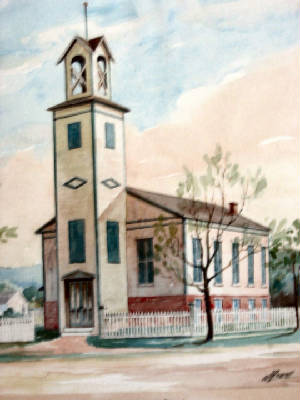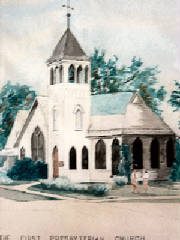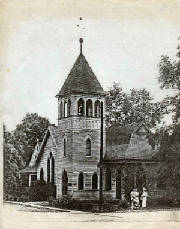|
The First Presbyterian Church of Ironton was started by Colonel Cyrus Russell
in 1838 as little frontier meetings. In 1841, it was officially organized as a Congregational Church and later became a member
of the Presbytery in 1855.
In the book A Connecticut Yankee in the Frontier Ozarks, author
T. P. Russell described the church meetings of 1838 as being held in "an old log cabin, with the walls made of logs, the roof
of split boards, the shingles fastened on by long logs to hold them down, the door hung with wooden hinges, not a window or
a light of glass; the chimney made of sticks and mud. ... Seats of rough boards, and slabs all around the house, and in the
center was a tall table for the preacher, with a chair beside it."
| The 1841 Church today-a private residence |
|
|
The first church building of the tiny congregation was built in 1841 by
Colonel Russell on his property. The two story brick building served as a church and a school. The church occupied the first
floor while the school was on the second. This building still stands and is a private residence in good repair. The church
continued for twelve years or so and was served by Methodist, Congregationalist and Presbyterian ministers. During this settlement
time, ministers and other people came and then, often times, moved on. In 1855 when it joined the Presbytery, it was named
First Presbyterian Church of Arcadia.

Construction of the first church located at its present site in Ironton, then the
new county seat of Iron County, was begun in 1860 on two lots
donated by W. S. Tong and David Carson. At that time the name was changed to First Presbyterian Church of Ironton reflecting
it's new location. The basement was ready for worship services by December. The building, though not completed at the time,
served as a hospital for the Union Army during the Civil War; the Battle of Pilot Knob took place nearly on the church's doorsteps.
Writing in 1945, Anne Keach Delano described the church: "There were two large doors at the entrance. Inside, a wide flight
of twelve or fifteen steps led up to a vestibule which extended across the entire front of the building except for the space
taken by enclosed stairways at each end, winding crookedly up to a gallery intended for the colored servants who came to worship
with their owners, or former owners, for the church was not completed until after the war." The basement of the church was
used as a school for three months in 1865. One evening in 1875, a chandelier fell and broke as it was being lit. The oil caught
fire, but was extinguished by the sexton when he threw his overcoat over the blaze thus averting a catastrophe. The congregation
did buy him a new overcoat. The small church was an integral part of the community. Spelling bees and social events were held
in the church.

The second building, erected in 1901, on the current site was dedicated on December
8 of that same year. Records indicate that the 1901 church was built on the basement of the 1860 church after it was razed
to make way for the new church. In 1965-66 the church was enlarged and remodeled and the steeple/bell tower was removed. The
handsome stainless steel cross on the east gable was also added that year as a memorial for Beverly Adams who died at age
12 of a brain tumor. A 2005 renovation, a memorial to Lucy Huff, returned the interior to a period closer to its 1901 origins.
The ceiling is as it was in 1901. The building is laid out in the form of a cross and the vaulted, bead-board paneled ceiling
and the roof is supported by uniquely designed exposed interior trusses. The church bell, by legend, was brought here many
years ago from the East and is from a sailing ship. The bell has announced the beginning of Sunday worship services for many
Sundays and also tolls in mourning for those of the flock who have departed. In 1983, white and red paraments were presented
as memorials for Elder Richard Wightman and Reverend Harold Barth respectively. The beautiful stained glass windows, designed
by Rob Huff and executed by Joyce Huff, became part of the church in 1989, a memorial for Robert Jones. The Fellowship Hall
was added in 1992. The beautiful new organ, a memorial for Bettie Boring, was dedicated in 2005.
The Ironton and Fredericktown churches were joined by a yoke arrangement that
began November 25, 1979. 1980 marked the beginning of the St. Francis Currents, the dual church's newsletter, named
for the St. Francis
River which flows between the Ironton church and the Fredericktown church.
The church has been active in the Ironton community throughout its history and
is particularly involved in education. It has been the site of several schools and a host of school functions. Church members
support the community by serving on various committees and working with the University
of Missouri Extension program as members of the Council. It has been
a meeting place for various civic functions and organizations. The Ironton Community Easter Service, still continuing today,
grew out of a program started by a Sunday School teacher and her Sunday School class. Members continue contributing to and
helping in the local food pantry.
The church history brings to mind a sobering thought: The church is,
in actuality, the people who gather in that particular building for worship -- "Where two or three are gathered in my name
there shall I be also."
| Picture scanned from the Church Scrapbook. |

|
| The Church as it was in 1901. |
|

